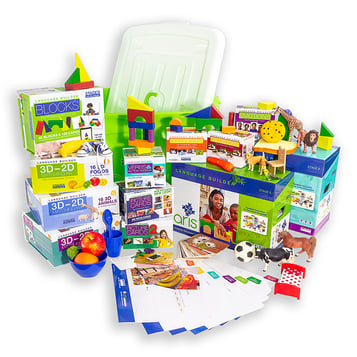Understanding the Differences Between Receptive and Expressive Languages: Teaching Autistic Children
Understanding the differences between receptive and expressive language can be a difficult task. These words are often used interchangeably, which can be confusing to the learners. More importantly, teaching language skills without a clear understanding of these two language building blocks can hinder the rate of progress. Autistic students sometimes have special challenges in developing receptive and expressive language skills. The following article provides some strategies for working with different types of learners.
What is the Difference Between Receptive and Expressive Language Skills?
We first start looking at how each of these terms is different from one another, and how we can teach a learner to increase their receptive and expressive language repertoire.
Receptive language refers to the learner’s ability to listen and understand and demonstrate understanding by their subsequent actions. At this learning stage when they are developing the receptive skill, the learner is learning to comprehend the information, and the confirmation of their understanding is from observing the student acting on it. For example, when a teacher says, “Point to the cookie”, the learner will locate the targeted item, and point to where it is placed in the learning environment. The targeted item (cookie) could be situated in its natural location in the setting (e.g. on the kitchen counter) or could be a picture of a cookie presented along with a few other pictures of various items in front of the learner from which the learner can choose.
 In contrast, expressive language skill is the learner’s ability to engage verbally with the environment and communicate wants and needs, and that could either be through speaking, gesturing, or both. For instance, a learner stating, “That’s a cookie”, or, “I want to eat a cookie”, or, “I am hungry. I need to eat something. I want to eat a cookie”. Alternatively, a learner who may have speech limitations can point to the cookie, or gesture for “more” to cue for the item of interest. In other situations, a learner may want to engage in both speaking and gesturing to express their desire, such as saying, “I would like some cookies up on the shelf” while pointing towards that direction. In this example, the learner is indicating the general direction of where the item is located while stating their request.
In contrast, expressive language skill is the learner’s ability to engage verbally with the environment and communicate wants and needs, and that could either be through speaking, gesturing, or both. For instance, a learner stating, “That’s a cookie”, or, “I want to eat a cookie”, or, “I am hungry. I need to eat something. I want to eat a cookie”. Alternatively, a learner who may have speech limitations can point to the cookie, or gesture for “more” to cue for the item of interest. In other situations, a learner may want to engage in both speaking and gesturing to express their desire, such as saying, “I would like some cookies up on the shelf” while pointing towards that direction. In this example, the learner is indicating the general direction of where the item is located while stating their request.
Which One to Teach First: Receptive or Expressive Language?
This would depend on the learner and their ability to connect and network between the two skills. With typical child development, a learner has less restriction in understanding and connecting the two concepts together. One may learn receptive language first by identifying that the presented object is a “car”, and would then bridge that concept naturally to engage in expressive language by speaking or saying “car” or “that is a car” without the need for direct or formal instruction. Alternatively, the learner may be taught to say “car” as the first skill and naturally would understand the concept of receptive language by identifying the object (e.g. the teacher says, “Let’s go get the car to play with”, and the learner obtains a car to play with).
In non-typical child development, such as with an autistic child, a learner may have some level of restriction, such as maladaptive behaviors or language delay in bridging the receptive and expressive skills naturally. In this type of case, direct instruction would be needed using a systematic approach to develop that understanding.
Generally speaking, the learner is first formally taught the receptive skill across a range of categories, such as colors, shapes, numbers, letters, everyday common objects, emotions, actions, and so on. Once a set of targeted items has been learned through receptive identification, the teacher would move on to teaching expressive identification with those items for that specific category.
 Utilizing STAGES® Learning's Language Builder program in the ARIS® Academic Readiness Intervention System, the learner can develop their receptive and expressive language skills with over 1000 flashcards across a wide range of categories.
Utilizing STAGES® Learning's Language Builder program in the ARIS® Academic Readiness Intervention System, the learner can develop their receptive and expressive language skills with over 1000 flashcards across a wide range of categories.
Phase I:
When introducing the learner to the receptive identification program using the Language Builder ARIS flashcards, the teacher can start with one picture card of the targeted item, for example, “airplane”, placed in front of the learner, and ask the learner to “point to the airplane”.
Phase II:
In the next phase, the teacher can place a second picture card along with the targeted picture card to act as a distractor, for example, “airplane” and “truck”. Again, the teacher would ask the learner to “point to the airplane”, and the learner would need to distinguish between the targeted picture card and the distractor card by listening and comprehending the spoken instruction.
Phase III:
In the third phase, the teacher will add another distractor card, or even up to 5 distractor cards, to increase the level of discrimination between the targeted and non-targeted items. It is important to note here that the number of distractor cards when first introducing the program to the learner can vary. One learner can start with zero distractor cards, while a more advanced learner can start the program with 4 distractor cards.
After the learner has learned to receptively identify “airplane”, and a few other nouns in the same category (truck, bus, motorcycle, etc.), the teacher would transition the program to an expressive identification program, using the same flashcards. In this learning phase, the teacher would present the picture card of the “airplane” and ask the learner, “What is this?” The learner would then say “airplane” or in a complete sentence, “That is an airplane”.
Once the learner has developed the receptive and expressive repertoire with the flashcards, the teacher will generalize the skills to the natural environment. This could be the teacher asking the learner to get an airplane toy in the learner’s play area. If the learner knew different colors, the teacher could say, “Go get the red airplane.” While the learner plays with the airplane, the teacher could ask, “What is this?” or “What toy do you have?” for the learner to say “airplane” as a response.
Intraverbals
As the learner continues with the language program, the teacher can help the learner apply their receptive and expressive skills to having a simple conversation. This is called intraverbals.
Intraverbals refers to the learner’s response to another person’s verbal expression, and can be observed as the following:

Teacher: “Let’s go get a toy to play with.”
Learner: Grabs a red airplane from the table
Teacher: “That’s a great choice. What is it?”
Learner: “Airplane.”
Teacher: “What color is it?”
Learner: “It is red.”
Teacher: “Red is my favorite color. What’s your favorite color?’
Learner: “I like blue.”
As the teacher provides a verbal expression, such as a question or statement, the learner responds appropriately with a verbal expression to maintain a conversation for that period of time. In this social interaction, the learner is applying their receptive and expressive language skills through the process of language building.
What other situations do you see as potential learning opportunities to help the learners apply their language development skills? I’d love to hear your comments!

Brian Le, MS, BCBA
Brian has been providing treatment services since 2005 to individuals with special needs in the home and school settings. He has worked in the field of ABA as a clinical supervisor, behavior specialist, and parent education trainer. Brian is currently a regional director of behavioral health treatment based in southern California.




